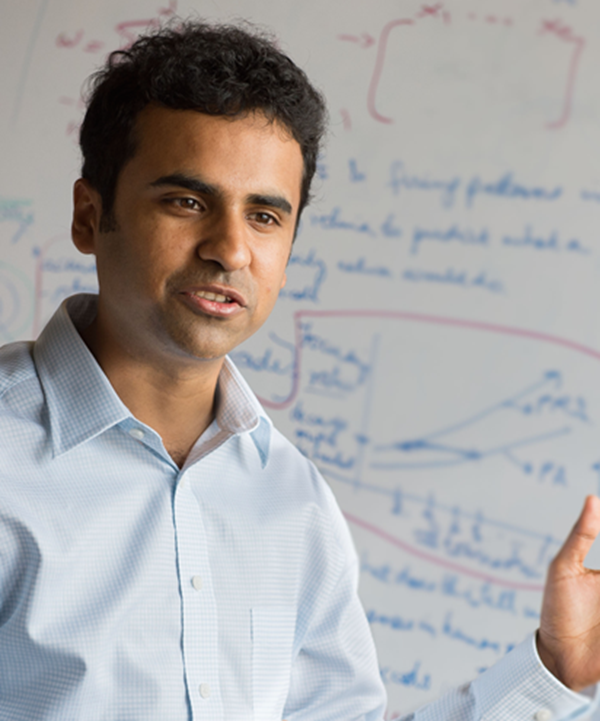“Theory and Practice of Tracking and Modulating Neural Activity: Information Flows, Neurostimulation, and Neural Silences”
Thursday, April 1 @ 1:00pm
Via Zoom
Email communications@ece.ufl.edu for Zoom info
Abstract
A central and widely studied problem in neuroscience is to understand the representation and flow of information in the healthy and diseased brain. The first part of Dr. Grover’s talk will draw from existing neuroscience literature and simple examples to arrive at the first formal definition of information flow in the brain, developing what is called the “M-Information Flow” framework. With this, Dr. Grover will show that it is possible to verifiably track information flow about a given message, and, further, obtain finer-grained information than is possible using existing tools. In obtaining this finer-grained information, his group leverages recent developments in information theory on “Partial Information Decomposition” (PID), which provides new tools for defining and estimating unique, redundant, and synergistic information. He will also see how synergy can arise in unexpected ways in the brain, through a case study of the so-called grid cells in the entorhinal cortex.
In practice, one not only needs to track the flow of information, but also modulate it. He will present some preliminary results on focused noninvasive neuromodulation using novel current focusing techniques. Finally, while much attention has been paid to tracking neural activity noninvasively, in many disorders, it is of interest to localize and track the lack of neural activity. He will describe his first algorithms for “silence localization”, and discuss disorders where this can be helpful.
To wrap up the talk, Dr. Grover will illustrate, through an example, why diverse representation in neuroscience is important, by telling the story of how an undergraduate student in my lab observed that wearable neural interfaces do not work for Black hair, and how she developed the first solutions for them.
The talk largely is based on the following joint works with Sanghamitra Dutta and Praveen Venkatesh (both in the academic job market!), as well as Arnelle Etienne, Mats Forssell, Chaitanya Goswami, and Alireza Chaman Zar:
- “Information Flow in Computational Systems” P Venkatesh, S Dutta, P Grover. IEEE Trans Information Theory, 2020.
- “Understanding Encoding and Redundancy in Grid Cells using the Partial Information Decomposition“ P Venkatesh, P. Grover, Cosyne’20.
- “How Else Can We define Information Flow in Neuroscience?” P Venkatesh, S Dutta, P Grover. IEEE ISIT 2019. and “How Should We define Information Flow in Neuroscience?” P Venkatesh, S Dutta, P Grover. IEEE ISIT 2018.
- “Novel Electrodes for Reliable EEG Recordings on Coarse and Curly Hair” A Etienne et al., IEEE EMBC’20.
- “Effect of skull thickness and conductivity on current propagation for noninvasively injected currents,”
M Forssell, C Goswami, A Krishnan, M Chamanzar, P Grover. Journal of Neural Engineering
- “Neural silences can be localized rapidly using noninvasive scalp EEG” A Chaman Zar, M Behrmann, P Grover. Nature communications biology, in press.
Biography
Dr. Pulkit Grover (Ph.D. UC Berkeley’10, B.Tech, M.Tech IIT Kanpur) is the Angel Jordan Associate Professor at Carnegie Mellon University. His main contributions to science are towards developing and experimentally validating a new theory of information (fundamental limits, practical designs) for efficient and reliable communication, computing, sensing, and control, e.g. by incorporating novel circuit-energy models and developing new mathematical tools for information flow analyses. To apply these ideas to a variety of problems including ethical AI and novel biomedical systems, his lab works extensively with data scientists, system and device engineers, neuroscientists, and clinicians. Specifically, work of his informational foundations of neuroengineering and cognition lab is focused on a) fair AI at algorithm, theory, and hardware levels; b) tools (theoretical, computational, and hardware) for understanding, diagnosing, and treating disorders such as epilepsy, Parkinson’s, and traumatic brain injuries. Pulkit is leading the SharpFocus team in response to DARPA’s Next-generation Nonsurgical Neurotechnology (N3) challenge, one of the 3 teams attempting to sense/stimulate the human brain noninvasively at unprecedented resolution.

